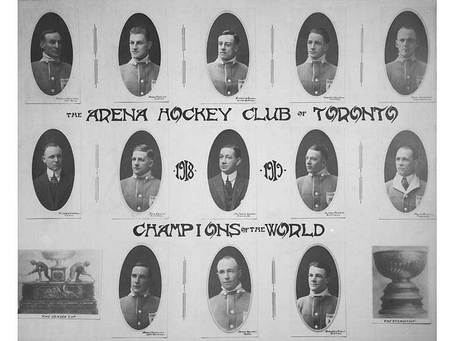"History is written by the victors." - Winston Churchill
(Not everything I write will come from Holzman and Nieforth's Deceptions and Doublecross: How the NHL Conquered Hockey - actually, quite a bit doesn't - but it's a good bet that this book will have influenced it. Seriously - go get a copy and read it. It's good. Wikipedia is also your friend.)
Karma
One of the striking things about the whole move to oust Eddie Livingstone and the Blueshirts from the NHA is how little most of those involved profited by it. Virtually everyone involved in the process was out of professional hockey in very short order.
The most dramatic case involved Sam Lichtenhein, owner of the Wanderers and Livingstone's most vocal foe. His team survived just six games into the NHL era. The Wanderers had been suffering at the gate for a while, completely outcompeted by the Canadiens. With Livingstone out, it's possible that the other owners began to take particular notice of how difficult Lichtenhein was to get along with. For whatever reason, his pleas (or more accurately, his imperious demands) for help all fell on deaf ears. He would stick around to vote on NHA matters, so long as it meant stopping Livingstone from getting anything started, but he'd never be a factor again.
George Kennedy of the Habs got sick in the flu epidemic of 1919 and was never really healthy again. He died in 1921. The Canadiens are apparently still playing. Now, it seems to me that it's got to be close to 100 years since that franchise was founded. You'd think they'd have mentioned it. Odd.
There was a coup at the top of the Senators organization in 1919. Long-time NHA mogul Martin Rosenthal was ousted by local arena owner Edgar Dey. Dey was actually able to use Livingstone and his attempts to start a new league as a means to gain control of the franchise. The Senators, though, would not survive the Depression.
The Quebec Bulldogs wound up as the Hamilton Tigers as Frank Calder angled to keep Hamilton (and it's lovely new arena) out of the clutches of Livingstone and his new league. Calder would later suspend the entire Hamilton team for threatening a player's strike. The players would later be reinstated so that they could form the New York Americans. Hamilton never got another team.
Thanks to Livingstone's lawsuits, Charlie Querrie had to sell the St. Patricks to Conn Smythe. This put Querrie out of the NHL. Smythe put up his own building four years later, rendering the Mutual Street Arena into a secondary facility that got by on political rallies and roller derby. It was sold in the 1930s for back taxes.
So in the end, nobody really profited from the explusion of Livingstone - nobody, that is, save for Frank Calder.
*****
Thoughts on Calder
Calder is a really interesting story. At the beginning, I likened his transition to that of Anakin Skywalker. A better comparison would have been the evolution of, say, an Elliot Ness-type character into Don Corleone. This lily-white crusading journalist, the exposer of corruption in sport, is somehow recruited as the bagman for a bunch of self-serving Montreal hockey owners and parlays this into a position where he's the unquestioned don of hockey, crushing opposition more or less at will.
This transformation (if that's accurate) of Calder is something I wish had been handled in greater detail. Holzman and Nieforth clearly have no use for the man - no, that's really an understatement. They hate him. I have no evidence that they are particularly wrong to feel the way that they do, but it's so evident in the book that I can't really split Calder's actions from their presentation of them. His evolution really isn't their subject matter, and other than knowing that they really, really dislike him, I still don't have a good sense of who he was or what all of his motives were.
So I can't answer the question as to whether Calder was the relentless and driven yet much-beloved master strategist or instead the ruthless mob boss. I'm largely inclined to side with H&N, but I'm not really a neutral observer, either. The standard storyline is that he was the former, but as with most everything, to the victor in the hockey wars went the spoils. It certainly helped Calder's legacy that in the employ of said victor (Calder/the NHL) were many of the writers of the prominent histories. As such, we hear that Calder was loved by one and all, Livingstone was a beast who was cast aside by the cleverness of the NHL, and the rest was "history."
Holzman and Nieforth beg to differ on that one.
(It should also be noted that some of the core NHL histories used newspaper accounts from Ottawa and Montreal as sources. Imagine a Leaf history based around Bruce Garrioch and Jack Todd articles....)
No matter his motives, Calder was extremely effective at doing what he set out to do. He made the NHL the dominant league on the continent with complete control of the Stanley Cup, leaving every other league in a subservient position and only really able to function with his permission. Those who opposed him found themselves out of hockey in a real hurry.
*****
A last word on Eddie Livingstone
Livingstone wasn't a saint. He was as competitive as anyone and it was not unknown for him to live more by the letter of the law than by its spirit. That said, the things done to him were far worse than the things he tried himself. He worked in a league that routinely tolerated tampering with his players, sometimes on a game-by-game basis. He dealt with top players being forcibly removed from his lineup and games being handed to rival teams in his own league. He had his team suspended without cause or compensation, leaving him on the hook for lease expenses. Finally, his entire roster of players was taken from him without compensation not once, but twice.
Through it all, he fought.
He never regained control of his team. Through his actions, though, he managed to get it away from those who stole it and help deliver it into the hands of the person who would take it to its greatest heights - Conn Smythe.
For all that Eddie Livingstone was supposed to be persona non grata in NHL circles, Conn Smythe didn't seem to have had any problems with him. In later years, Livingstone was involved in junior hockey in Toronto and he was always able to get ice - not at the Mutual Street Arena, but in Conn Smythe's Maple Leaf Gardens. There was room in Conn Smythe's world for Eddie Livingstone.
*****
The Blueshirts and the Leafs
Are the Maple Leafs really Eddie Livingstone's Blueshirts? Is there a missing fourteenth banner that should be hanging from the rafters at the ACC?
It's a hard question to answer, really, and it all comes down to how one defines a team.
From a legal standpoint, they certainly aren't the same thing. The entire purpose of everything that happened after 1917 was to make sure that the Blueshirts and Arenas were legally distinct. Those involved had to obscure the relationship between the teams as best as possible in order to limit their liability to Livingstone's lawsuits.
Further, the Arenas were a different legal entity than the team that played in 1917-18 and the St. Pats were a different legal entity than the Arenas. I have no idea whether the Leafs are the same thing, legally, as the St. Pats, or even whether the current structure that is MLSE really owns Conn Smythe's team, or whether it owns some other business construct that came later.
The NHL also granted new "franchises" to each of the early incarnations of Toronto NHL teams whenever the ownership structure changed. Continuity of franchise wasn't something that was considered relevant. If anything, that continuity was continually broken to aid in the legal fights.
So what makes a team? The NHL and Leafs recognize the relationship of the current team to those prior NHL entries, even if they operated under different names, ownership groups, even franchise charters. Their records are bundled with the Leaf records, their banners hang with the Leaf banners.
What drives the connection? There is a chain of ownership that can be followed, and moreso there is a continuity of players that move with the team from incarnation to incarnation. The team was more about who played on it than who happened to own it at any given moment.
I find it interesting that the Arenas of 1918-19, constructed specifically NOT to be Eddie Livingstone's Blueshirts, represent themselves as the defending Stanley Cup champions. The point they make is that they might be named differently and owned by different people, but they're really the same team in every way that matters - the same team that had played and won in 1917-18 - and that team was Eddie Livingstone's. They had been borrowed for a year and now taken for keeps, but they were still the same team.
In any respect, it doesn't really matter. It doesn't change anything about the current situation if the Leafs add a banner from 1914 to the others hanging in the rafters. That Cup won't really be meaningful until the Leafs have won another 10, (and then it'll be REALLY important). :)
What does matter, to me at least, is not so much that we've left out the banner as much as we've forgotten the team and the people who were on it. People who were a big part of this city have been allowed to disappear from the record. This is likely as much by accident as by design, but they're gone all the same. Scotty Davidson, Harry Cameron, Hap Holmes, Corb Denneny, Babe Dye - these were all names that would roll off the tongue of a Toronto hockey fan every bit as easily as a Sittler, Clark, Gilmour or Sundin would decades later. They've been allowed to drop out of our consciousness, and that shouldn't happen.
I took a little swipe at Montreal above, but they really know how to make use of their history and how to keep the names alive. They appreciate it in a way we never have here.
In a couple of years, it will be a century since the Blueshirts and Tecumsehs (formerly Cobalt and Renfrew) first played in the NHA (the anniversary of the old Toronto Professionals has already come and gone - that was in '06). It would be nice if it were acknowledged - or even better - celebrated.
The current Leaf ownership is so many generations removed from Eddie Livingstone that there is no taint of the actions of 1917 remaining. It's time to acknowledge these people and give them their due - not just for their sakes, but for ours, too.
The history belongs to all of us.
*****
This does it for this particular series. It took a lot longer than I thought and became much more involved than I expected. I have some thoughts as to where to go next, but won't tip my hand there just yet.
Oh - and PS - the book is great. Go read it and see where I messed up.






Comment Markdown
Inline Styles
Bold: **Text**
Italics: *Text*
Both: ***Text***
Strikethrough: ~~Text~~
Code: `Text` used as sarcasm font at PPP
Spoiler: !!Text!!